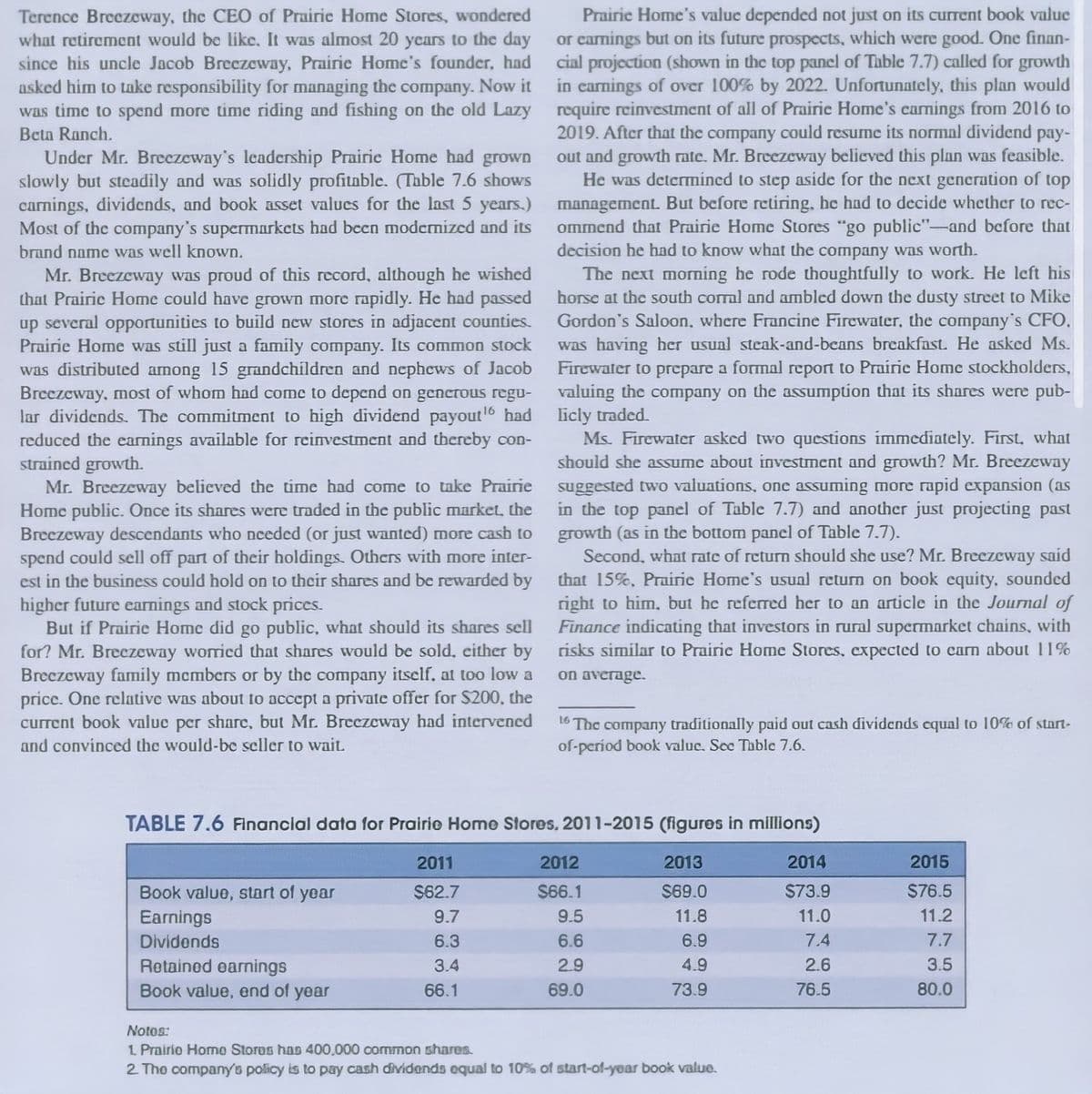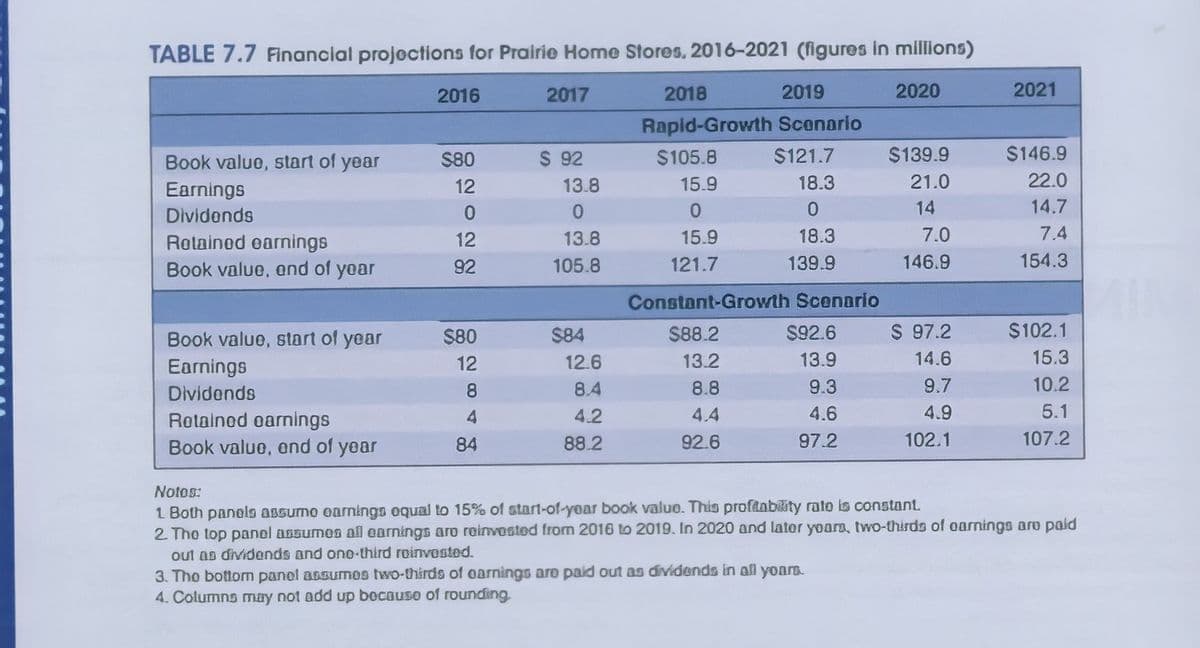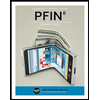TABLE 7.7 Financlal projections for Prairie Home Stores. 2016-2021 (figures in millions) 2016 2017 2018 2019 2020 2021 Rapid-Growth Scenario Book valuo, start of year S80 $ 92 $105.8 $121.7 $139.9 $146.9 12 13.8 15.9 18.3 21.0 22.0 Earnings Dividends 14 14.7 Rotained earnings 12 13.8 15.9 18.3 7.0 7.4 Book value, end of yoar 92 105.8 121.7 139.9 146.9 154.3 Constant-Growth Scenario Book value, start of year $80 $84 $88.2 $92.6 $ 97.2 $102.1 Earnings 12 12.6 13.2 13.9 14.6 15.3 Dividends 8. 8.4 8.8 9.3 9.7 10.2 4.2 4.4 4.6 4.9 5.1 Rotained oarnings Book value, end of year 4. 84 88.2 92.6 97.2 102.1 107.2 Notos: 1 Both panels assumo earnings oqual to 15% of start-of-yoar book value. This proftability rato is constant 2 Tho top panel assumes al earnings aro reinvested from 2016 to 2019. In 2020 and later yoars, two-thirds of oarnings aro paid out as dividends and ono-third roinvosted. 3. Tho botlom panel assumos two-thirds of oarnings are paid out as dividends in all yoars. 4. Columns may not add up becauso of rounding.
TABLE 7.7 Financlal projections for Prairie Home Stores. 2016-2021 (figures in millions) 2016 2017 2018 2019 2020 2021 Rapid-Growth Scenario Book valuo, start of year S80 $ 92 $105.8 $121.7 $139.9 $146.9 12 13.8 15.9 18.3 21.0 22.0 Earnings Dividends 14 14.7 Rotained earnings 12 13.8 15.9 18.3 7.0 7.4 Book value, end of yoar 92 105.8 121.7 139.9 146.9 154.3 Constant-Growth Scenario Book value, start of year $80 $84 $88.2 $92.6 $ 97.2 $102.1 Earnings 12 12.6 13.2 13.9 14.6 15.3 Dividends 8. 8.4 8.8 9.3 9.7 10.2 4.2 4.4 4.6 4.9 5.1 Rotained oarnings Book value, end of year 4. 84 88.2 92.6 97.2 102.1 107.2 Notos: 1 Both panels assumo earnings oqual to 15% of start-of-yoar book value. This proftability rato is constant 2 Tho top panel assumes al earnings aro reinvested from 2016 to 2019. In 2020 and later yoars, two-thirds of oarnings aro paid out as dividends and ono-third roinvosted. 3. Tho botlom panel assumos two-thirds of oarnings are paid out as dividends in all yoars. 4. Columns may not add up becauso of rounding.
Chapter9: Projecting Financial Statements
Section: Chapter Questions
Problem 5EP
Related questions
Question

Transcribed Image Text:Terence Breczoway, the CEO of Prairic Home Stores, wondered
what retirement would be like. It was almost 20 years to the day or camings but on its future prospects, which were good. One finan-
since his uncle Jacob Breezeway, Prairie Home's founder, had
asked him to take responsibility for managing the company. Now it
was time to spend more time riding and fishing on the old Lazy require reinvestment of all of Prairie Home's carmings from 2016 to
Prairic Home's value depended not just on its current book value
cial projection (shown in the top panel of Table 7.7) called for growth
in carnings of over 100% by 2022. Unfortunately, this plan would
2019. After that the company could resume its normnl dividend pay-
out and growth rate. Mr. Breezeway believed this plan was feasible.
He was determined to step aside for the next generation of top
Beta Ranch.
Under Mr. Breezeway's leadership Prairie Home had grown
slowly but steadily and was solidly profitable. (Table 7.6 shows
carnings, dividends, and book asset values for the last 5 years.) manngement. But before retiring, he had to decide whether to rec-
Most of the company's supermarkets had been modernized and its
ommend that Prairie Home Stores "go public"-and before that
decision he had to know what the company was worth.
The next morning he rode thoughtfully to work. He left his
brand name was well known.
Mr. Breczeway was proud of this record, although he wished
that Prairic Home could have grown more rapidly. He had passed horse at the south corral and ambled down the dusty street to Mike
up several opportunities to build new stores in adjacent counties.
Prairie Home was still just a family company. Its common stock
was distributed among 15 grandchildren and nephews of Jacob
Breczewny, most of whom had come to depend on generous regu-
lar dividends. The commitment to high dividend payoutl6 had
reduced the earnings available for reinvestment and thereby con-
strained growth.
Mr. Breezeway believed the time had come to take Prairie
Home public. Once its shares were traded in the public marketL the
Breczeway descendants who nceded (or just wanted) more cash to
spend could sell off part of their holdings. Others with more inter-
est in the business could hold on to thcir shares and be rewarded by
higher future earnings and stock prices.
But if Prairie Home did go public, what should its shares sell
for? Mr. Breczeway worried that shares would be sold, either by
Breczeway family mcmbers or by the company itself, at too low a
price. One relative was about to accept a private offer for $200, the
current book valuc per share, but Mr. Breczeway had intervened
and convinced the would-be seller to wait.
Gordon's Saloon, where Francine Firewater, the company's CFO,
was having her usunl steak-and-beans breakfast. He asked Ms.
Firewater to prepare a formal report to Prairic Home stockholders,
valuing the company on the assumption that its shares were pub-
licly traded
Ms. Firewater asked two questions immediately. First, what
should she assume about investment and growth? Mr. Breezeway
suggested two valuations, one asouming more rapid expansion (as
in the top panel of Table 7.7) and another just projecting past
growth (as in the bottom panel of Table 7.7).
Second, what rate of return should she use? Mr. Breezeway said
that 15%, Prairie Home's usual return on book equity, sounded
right to him, but he referred her to an article in the Journal of
Finance indicating that investors in rural supermarket chnins, with
risks similar to Prairie Home Stores, expected to carn about 11%
on average.
16 The company traditionally paid out cash dividends cqual to 10% of start-
of-period book value. Sec Table 7.6.
TABLE 7.6 Flnanclal data for Prairio Home Stores, 2011-2015 (figures in millions)
2011
2012
2013
2014
2015
Book value, start of yoar
$62.7
$66.1
S69.0
$73.9
$76.5
Earnings
9.7
9.5
11.8
11.0
11.2
Dividends
6.3
6.6
6.9
7.4
7.7
Retained earnings
Book value, end of year
3.4
2.9
4.9
2.6
3.5
66.1
69.0
73.9
76.5
80.0
Notos:
1 Prairio Homo Storos has 400,000 common shares.
2 Tho company's policy is to pay cash dividonds equal to 10% of start-of-year book value.

Transcribed Image Text:TABLE 7.7 Financlal projoctions for Prairie Home Stores, 2016-2021 (figures in millions)
2016
2017
2018
2019
2020
2021
Rapid-Growth Scenario
Book valuo, start of year
S80
$ 92
$105.8
$121.7
$139.9
$146.9
Earnings
12
13.8
15.9
18.3
21.0
22.0
14
14.7
Dividonds
12
13.8
15.9
18.3
7.0
7.4
Rotainod earnings
Book value, and of yoar
92
105.8
121.7
139.9
146.9
154.3
Constant-Growth Scenario
Book value, start of year
$80
$84
$88.2
$92.6
$ 97.2
$102.1
Earnings
12
12.6
13.2
13.9
14.6
15.3
Dividonds
8.
8.4
8.8
9.3
9.7
10.2
Rotainod earnings
4
4.2
4.4
4.6
4.9
5.1
Book value, end of year
84
88.2
92.6
97.2
102.1
107.2
Notos:
1 Both panels assumo oarnings oqual to 15% of start-of-yoar book valuo. This proftability rato is constant.
2 Tho top panol assumos afl carnings aro reinvosted from 2016 to 2019. In 2020 and lator yoars, two-thirds of oarnings aro paid
out as dividends and one-third roinvosted.
3. Tho botlom panel assumos two-thirds of oarnings aro paid out as dividends in all yoars.
4. Columna may not add up bocauso of rounding.
Expert Solution
This question has been solved!
Explore an expertly crafted, step-by-step solution for a thorough understanding of key concepts.
Step by step
Solved in 2 steps

Knowledge Booster
Learn more about
Need a deep-dive on the concept behind this application? Look no further. Learn more about this topic, accounting and related others by exploring similar questions and additional content below.Recommended textbooks for you


Pfin (with Mindtap, 1 Term Printed Access Card) (…
Finance
ISBN:
9780357033609
Author:
Randall Billingsley, Lawrence J. Gitman, Michael D. Joehnk
Publisher:
Cengage Learning

PFIN (with PFIN Online, 1 term (6 months) Printed…
Finance
ISBN:
9781337117005
Author:
Randall Billingsley, Lawrence J. Gitman, Michael D. Joehnk
Publisher:
Cengage Learning


Pfin (with Mindtap, 1 Term Printed Access Card) (…
Finance
ISBN:
9780357033609
Author:
Randall Billingsley, Lawrence J. Gitman, Michael D. Joehnk
Publisher:
Cengage Learning

PFIN (with PFIN Online, 1 term (6 months) Printed…
Finance
ISBN:
9781337117005
Author:
Randall Billingsley, Lawrence J. Gitman, Michael D. Joehnk
Publisher:
Cengage Learning


Financial & Managerial Accounting
Accounting
ISBN:
9781285866307
Author:
Carl Warren, James M. Reeve, Jonathan Duchac
Publisher:
Cengage Learning

Intermediate Financial Management (MindTap Course…
Finance
ISBN:
9781337395083
Author:
Eugene F. Brigham, Phillip R. Daves
Publisher:
Cengage Learning